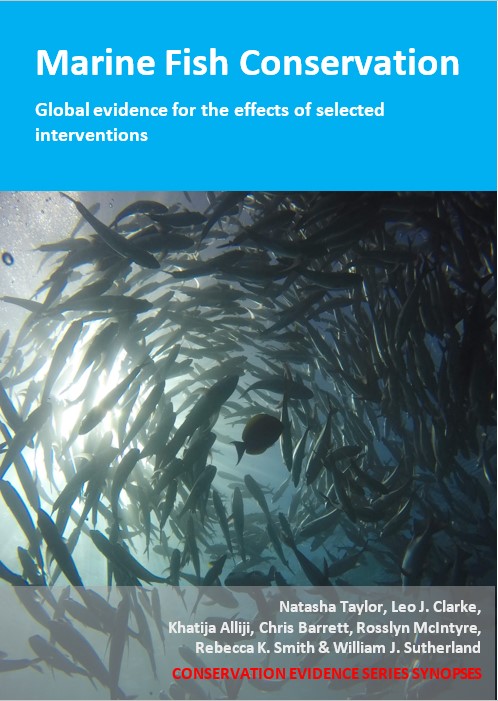Modify longline configuration
-
Overall effectiveness category Awaiting assessment
-
Number of studies: 4
View assessment score
Hide assessment score
How is the evidence assessed?
-
Effectiveness
not assessed -
Certainty
not assessed -
Harms
not assessed
Study locations
Supporting evidence from individual studies
A replicated, controlled study in 1995–1996 of two coastal pelagic areas in the Norwegian Sea, north Norway (Huse & Soldal 2000) found that increasing the lead weight on mid-water longlines to increase the sinking rate, did not typically reduce the catches of undersized haddock Melanogrammus aeglefinus compared to longlines with normal lead weight. The proportion of haddock below legal size (44 cm) was similar for both weights in three of four trials (double weight: 17–25%, normal weight: 16–21%) and catch rates were also similar (double: 52–70 fish/100 hooks, normal: 46–74 fish/100 hooks). In one of four trials however, the proportion of haddock below legal size was lower with double lead weight (double: 13%, normal: 17%) and haddock catch significantly higher (double: 91 fish/100 hooks, normal: 68 fish/100 hooks). Trials were carried out in July 1995 and June/July 1996 by two commercial longliners. Four separate trials were done, one by each vessel in one area both years. Each vessel fished a different number of hooks/rigging configuration (see paper for specifications), all baited with mackerel. The lead weight on sets of longlines was doubled and the sets deployed alternately with lines with normal lead weight. A total of 14,022 and 26,353 hooks were set for modified lines and normal lines respectively. Numbers of fleets deployed, or their distances apart, were not specified. Numbers and lengths of captured haddock were recorded.
Study and other actions testedA replicated, controlled study in 2011 in an area of pelagic water in the southwestern Atlantic Ocean off Brazil (Afonso et al. 2012) found that modifying the configuration of tuna fishery longlines by using a nylon tether instead of a steel wire tether to suspend the hooks reduced the overall capture of unwanted sharks, but also reduced shark survival. Catch rates of all sharks combined were lower on nylon tethers than steel, irrespective of hook type (nylon: 4 sharks/1,000 hooks, steel: 8 sharks/1,000 hooks). However, if hooks that were bitten off were included (assumed to be by sharks) no effect of tether type was found (nylon: 8–12 sharks/1,000 hooks, steel: 8 sharks/1,000 hooks) and almost all occurred on nylon tethers. On nylon tethers only 34% of the shark catch (n=56) was alive compared to 54% (n=86) on steel tethers. Data were collected in January 2011 from 17 longline set deployments on a commercial fishing vessel. Longlines were made of nylon monofilament (3.5 mm diameter) and 90 km length. Each set had 1,000 hooks (total 17,000 hooks), randomly arranged with either nylon or stainless steel tethers and circle or J shaped hooks, baited with squid Illex sp.
Study and other actions testedA review in 2013 of two studies in a meta-analysis of 27 studies to assess methods to reduce unwanted shark and ray (Elasmobranchii) catches in longline fisheries worldwide (Favaro & Côté 2015) found that modifying the configuration of longlines by using nylon lines instead of wire lines to attach the hooks to the main longline reduced the overall amount of unwanted sharks and rays caught in one of two cases. Numbers of sharks and rays caught on breakable monofilament lines were 58% lower than on wire lines. However, tarred multifilament nylon lines (designed to make them easier for fish of all species to see and avoid) caught similar numbers of sharks and rays to traditional wire branch lines (data reported as graphical analysis). The systematic review summarized 44 datasets from 27 studies of the effects of various actions to reduce unwanted shark and ray catch, and identified one study comparing breakable monofilament nylon lines with wire lines and one comparing tarred multifilament lines instead of wire lines. Full literature search methods are reported in the original paper.
Study and other actions testedA review of 41 worldwide studies in 2016 of various methods to reduce unwanted shark and ray (Elasmobranchii) catches in pelagic longline fisheries (Gilman et al. 2016) found that modifying the configuration of longlines by using monofilament leader lines (to attach the hooks) instead of wire reduced the number of unwanted elasmobranchs caught, and survival at retrieval varied between species. Catch rates of elasmobranchs were lower for seven of 10 unwanted elasmobranch species using monofilament leader lines rather than wire, and higher for three species. Survival at gear retrieval was higher on monofilament leader lines for two of three species and lower for one compared to wire lines. The study performed a meta-analysis of 41 studies globally on the effects of different hook and bait types in pelagic longline fisheries on unwanted elasmobranch catch rates and survival.
Study and other actions tested
Where has this evidence come from?
List of journals searched by synopsis
All the journals searched for all synopses
This Action forms part of the Action Synopsis:
Marine Fish Conservation





)_2023.JPG)














